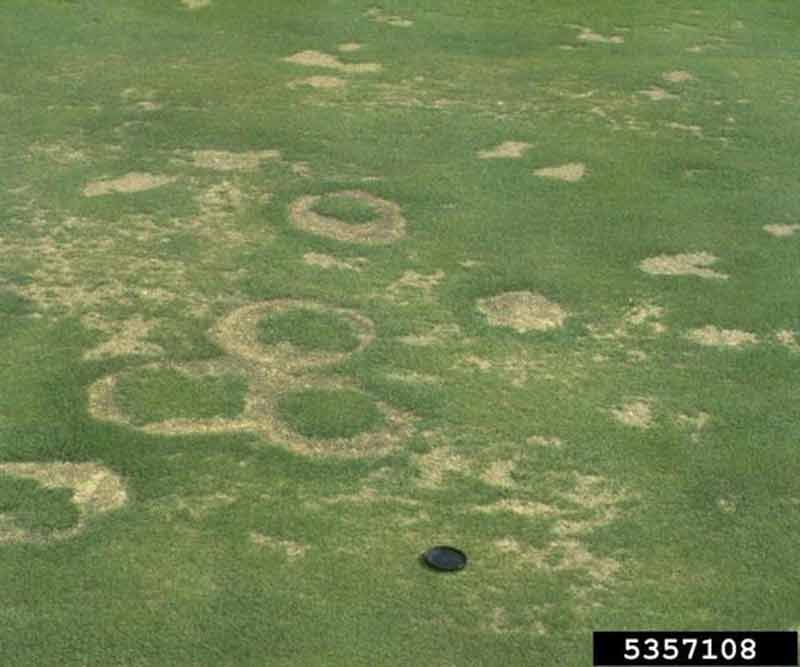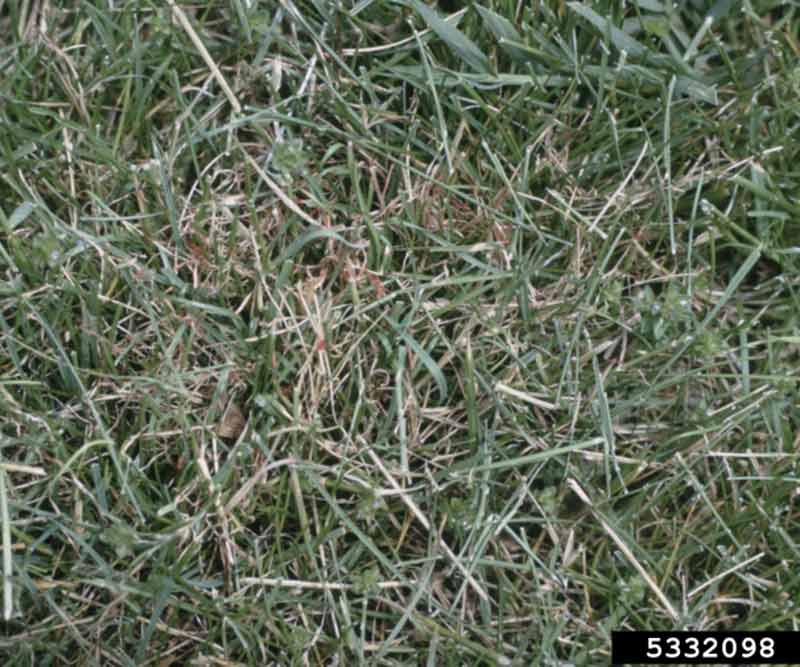How to Identify and Control Snow Mold
Photo credit: William M. Brown, Jr., Bugwood.org (CC BY 3.0 US)
When lawn disease strikes, your dreams of a thick, beautiful lawn may seem to slip out of reach. But the solution to your problems can be as simple as disease I.D. and changes in your lawn care routine. Most common lawn diseases start with fungal pathogens that can't flourish unless conditions favor their growth. With proper lawn disease identification and disease-fighting culture, you can control disease and enjoy a healthy lawn:
- How to Identify and Control Brown Patch
- How to Identify and Control Dollar Spot
- How to Identify and Control Fairy Rings
- How to Identify and Control Red Thread
- How to Identify and Control Rust
- How to Identify and Control Snow Mold
How to Identify and Control Brown Patch
Brown patch disease strikes lawns from late spring through summer months, continuing into fall. All parts of the grass plant — from roots to blade tips — are affected by this disease. Bermudagrass, perennial ryegrass, and tall fescue are common brown patch targets. The disease often attacks fine fescues and Kentucky bluegrass as well.1,2
- Symptoms and signs: Brown patch may show itself as early as spring green-up, especially in Bermudagrass lawns. Sunken, circular patches of dead, tan grass appear, measuring up to 3 feet in diameter. The patches expand up to 20 feet wide, ringed with smoky, grayish margins of wilted, dark, dying grass.
- Contributing factors: High humidity combined with hot temperatures during spring and fall favor the development of brown patch disease. Overfertilizing, overwatering, heavy thatch buildup, and mowing too short contribute to the disease.
- Cultural control: Fight brown patch disease with good water management to avoid overwatering. Water early in the day, so grass dries well by night. Avoid excessive nitrogen fertilizer, and dethatch if your thatch layer is more than 1/2 inch thick. Follow guidelines for proper mowing to avoid mowing too short.

Photo credit: Kevin Mathias, Bugwood.org (CC BY 3.0 US)
How to Identify and Control Dollar Spot
Active from spring through summer and fall, dollar spot disease focuses on grass leaves. Frequent hosts of dollar spot include perennial ryegrass, fine fescue and centipede grass, but tall fescue, Kentucky bluegrass, Zoysia grass and Bermudagrass are also susceptible. Late summer can be particularly tough for lawns with dollar spot.1,2
- Symptoms and signs: Grass blades affected with dollar spot look water-soaked and show yellow spots ringed in reddish brown. Yellow-tan, "silver-dollar-size" lawn spots start about 2 to 6 inches wide, but then grow into large, irregular patches. Cobweb-type growth appears between blades.
- Contributing factors: Dollar spot thrives when warm, humid days pair with cool nights. Water stress, from drought or excess moisture, support the disease. Underfertilizing and excess thatch contribute as well.
- Cultural control: Fertilize with high-quality nitrogen fertilizers to help keep dollar spot at bay. Avoid water stress. Time irrigation for early morning to reduce the time that grass stays wet. Raise your mowing height during hot periods to limit drought stress.

Photo credit: William M. Brown Jr., Bugwood.org (CC BY 3.0 US)
How to Identify and Control Fairy Rings
Midsummer is high season for fairy rings, but this fungal lawn disease stays active from spring into late fall. No common lawn grass species — cool-season or warm-season grasses — are immune to this disease, which arises from at least 40 separate fungal species.1,2
- Symptoms and signs: Large, irregular rings throughout your lawn reveal fairy rings at work. Rings may be dark green from the fungi's release of nitrogen, or rings may be tan, with green grass within. Telltale puffballs or mushrooms appear along the ring. Fairy ring areas may repel rainfall and irrigation.
- Contributing factors: The fungi behind fairy rings depend on dead or decaying organic matter for their survival. Soil with overly high organic matter or turf with excessive thatch contribute to the disease.
- Cultural control: When starting a new lawn from seed, avoid high-organic soil mixes and remove any wood pieces or excess organic matter before you seed. Dethatch your lawn, if needed, and keep it hydrated well. If necessary, core aerate affected lawn areas so water can penetrate the root zone.

Photo credit: Mary Ann Hansen, Virginia Polytechnic Institute and State University, Bugwood.org (CC BY 3.0 US)
How to Identify and Control Red Thread
Red thread disease prospers during moderate temperatures, attacking grass leaves from early to late spring and again from late summer into fall. Perennial ryegrass and fine fescue are particularly susceptible to pathogens behind this disease, but red thread affects bluegrasses and bentgrasses, too.1,2
- Symptoms and signs: Reddish-pink discoloration on your shoes, mower and lawn tools is a clear signal of red thread disease. Closer inspect reveals reddish-pink threads throughout your lawn. Grass leaves wither from the tip to the ground as red thread progresses, creating red-tinged or bleached-out patches in lawns.
- Contributing factors: Cool, wet spring temperatures provide ideal conditions for red thread's development. Poor air circulation, too much shade, high humidity, and extended periods of wet grass all support this disease. Underfertilizing, compacted soil and excessive thatch also contribute.
- Cultural control: Remove lawn clippings to improve air circulation and battle red thread disease. Fertilize regularly with premium high-nitrogen lawn fertilizers, and irrigate early in the day so sun and wind dry grass fast. Aerate compacted lawns and remove excess thatch. For shaded lawns, choose grasses that do well in shade.

Photo credit: Clarissa Balbalian, Mississippi State University, Bugwood.org (CC BY 3.0 US)
How to Identify and Control Rust
Several different fungal pathogens cause rust diseases in lawns. Rust strikes grass leaves and stems in mild to moderate temperatures, beginning in spring, but it's often most prevalent in fall. Kentucky bluegrass, perennial ryegrass, tall fescue and Zoysia grass are common hosts for rust diseases.1,2
- Symptoms and signs: Rust first appears as yellowish leaf specks that develop red-orange fungal spores. Lawn areas grow thin and weak, forming large, irregular patches with a rusty tinge. Seasonal lawn care tasks leave shoes, lawn tools and mowers dusted with rusty orange-red spores.
- Contributing factors: Excessive moisture from high humidity, too much shade, poor air circulation and extended wetness all contribute to rust's germination and spread. Drought stress and underfertilization also support these diseases.
- Cultural control: Help prevent rust diseases by feeding your lawn adequate nitrogen. Water so grass gets adequate moisture, but never stays overly wet. Improve air circulation by mowing at recommended grass heights and removing grass clippings. Time irrigation for early morning, so grass dries in sun.
How to Identify and Control Snow Mold
Snow mold is a winter-related disease that strikes grasses during cold, wet periods from mid-fall through mid spring. As its name suggests, this disease often grows under snow cover, attacking shoots and staying hidden until snow melts. Tall fescue, fine fescue, perennial ryegrass and Kentucky bluegrass often struggle with snow mold disease.1,2
- Symptoms and signs: With snow mold present, melting snow reveals small, circular patches of water-soaked, red-brown grass that measure 1 foot or more across. Gray-white or pinkish fungal threads cover grass blades.
- Contributing factors: Overly cool, wet fall weather provides the conditions that lead to snow mold outbreaks. Excess moisture from high humidity, poor air circulation, poor drainage, excess thatch or too much shade support the disease. Overfertilizing in fall contributes to tender, vulnerable grass growth.
- Cultural control: Improve moisture issues by correcting drainage, enhancing air flow and dethatching as needed. Mow slightly lower than normal in fall, bag grass clippings, and remove fallen leaves. Avoid high-nitrogen fall fertilizers in areas where snow mold has occurred.
When cultural controls fail to manage fungal lawn diseases, a lawn fungicide can help. As with garden fungicides, early treatment is key to preventing fungal pathogens from germinating and spreading. Many effective fungicides are available only to lawn professionals. Your local county extension agent is an excellent source for information on lawn fungicides and their use for lawn diseases.
For any type of lawn disease, choosing disease-resistant grass varieties plays an important role in disease prevention and control. Superior grass varieties such as purebred Pennington Smart Seed grasses are backed by decades of industry-leading research and breeding to provide you with the finest in sustainability-enhancing lawn grasses with outstanding disease resistance.
By being proactive and providing your lawn with the care it needs, you can restore balance and enjoy a thick, healthy lawn again. Pennington is here to help with timely, expert lawn advice and premium seed and lawn care products, so you can know the satisfaction of a disease-free lawn you're proud to call your own.
Pennington with design and Smart Seed are trademarks of Pennington Seed, Inc.
Sources:
- NextGen Turf Research, "Disease Overview: Turfgrass Disease," April 2016.
- Bruneau and Lucas, "Diseases of Warm-Season Grasses," North Carolina State Extension, August 1995.
Photo credit: William M. Brown, Jr., Bugwood.org (CC BY 3.0 US)



